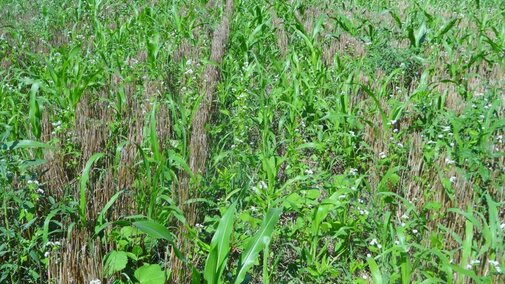Cover crops can be used for a variety of purposes including protecting the soil, improving soil structure, scavenging nutrients, fixing nitrogen, managing soil moisture, and feeding soil biological life. Fields that were hailed, flooded, windblown, or where planting was prevented this season need cover crops for all of these reasons.
A key soil health concept is that there should be something green and growing during as much of the year as possible. The roots of growing plants exude carbon compounds into the soil, forming mutually beneficial associations to feed the soil biology, especially arbuscular mycorrhizae fungi. These fungi help plants with water and nutrient uptake by essentially expanding the root system with their hyphae. Growing plants also make use of sunlight and carbon dioxide when they are available to produce biomass for the soil system.
Without a crop on storm-damaged fields this season, there will be little cover now or residue next year to protect soil from the raindrop impact that can cause erosion and crusting. Likewise, residue can keep the sun and wind off the soil surface to reduce wind erosion and soil water evaporation. While producers may want the soil to dry out now, without residue cover, evaporation will occur from the soil surface all year long, resulting in less water available for the next crop. Producers have found that while a properly managed cover crop uses some soil moisture as it grows, it tends to use less water than is lost to evaporation from a bare soil surface. Without a cover crop, Mother Nature will provide one by growing weeds. A cover crop greatly suppresses weeds, both while growing and with the residue produced.
Nitrogen Scavengers
If nitrogen was already applied for corn production and the crop was lost to hail or flooding, cover crops can be an effective way to take up the nitrogen and put it into a biological form, rather than lose it to leaching. The cover crop will release the nitrogen and add carbon to the soil system as its residue breaks down. With the heavy precipitation seen in many areas recently, the potential for leaching is high. The cover crop will use some soil moisture, making room in the soil profile for future rainfall. If the crop lost was soybeans, a legume cover crop could be used to “grow” some nitrogen to replace the lost nitrogen credit of the soybeans for next year’s corn crop. Legumes should be inoculated with the proper inoculant for the specie to help ensure nitrogen fixation.
For better soil and water conservation, grass cover crops provide the longest lasting residue cover because they have a higher carbon-to-nitrogen ratio in their biomass compared to non-grass species. In addition, they improve snow catch in the winter and reduce wind erosion in the spring compared to bare soil. Taller brassicas and broadleafs like rape, canola, African cabbage, and sunflowers will also stand nicely to reduce wind erosion and catch snowfall, but they provide less residue. When seeding now, warm season cover crops should be used to grow in the heat of the summer. If seeding in the fall, winter annual cover crops should be used.
The cover crop will add organic biomass both above and below ground and the growing roots will help rebuild soil structure. The fibrous roots of grasses help build soil stability near the surface. The deeper tap roots of broadleafs, especially brassicas, penetrate and open up tight soils, improving infiltration. The finer roots of legumes feed the soil microbes while the tap roots grow downward. Any root growing in the soil helps dewater excess soil moisture, provides some structural stability to the soil, and helps the mycorrhizae fungi recover. When using winter annual cover crops, these benefits can become very important if next spring is wet. If the spring looks like it will be dry, the cover crops need to be killed in a timely manner so as not to use too much soil moisture. Using cover crops which will frost-kill this fall or winter-kill allows more time for soil moisture recharge in the spring.
Cover Crop Mixtures
Cover crop cocktails, a mixture of several species and plant types, provide different rooting patterns and varying plant architecture to add diversity to the system. The diversity is valuable for restoring microbial and physical soil function. Mixtures also provide good soil cover across a variety of conditions as the different cover crop types respond differently to varying soil and weather conditions. As an example, a mixture of a warm season grass (millet or sorghum sudan), a cool season grass (oats or cereal rye), a cool season legume (forage peas or hairy vetch), and a brassica (rapeseed or radish) would provide some quick cover this summer, some nutrient scavenging, some nitrogen fixation, and more cover in the spring, while helping build the soil system. Cover crop cocktails should be used as much as possible to accomplish multiple objectives.
Before seeding any cover crops, check with your insurance provider to see if there are any rules or restrictions. Carefully select the cover crop species, depending on the herbicide program used previously in the field and the resource needs to be addressed. If you're considering haying or grazing the cover crop, it may affect insurance or disaster payments as something will be produced and herbicide plant-back restrictions must be followed. Cover crops are often grown and left in the field to benefit the soil system. Forage cover crops are used for haying or grazing and should be treated as a crop for best production. By not removing all of the forage, these crops can still benefit the soil system because of the actively growing roots and the remaining residue cover.

